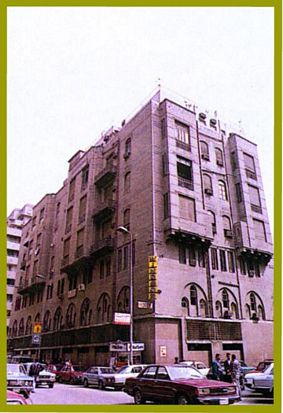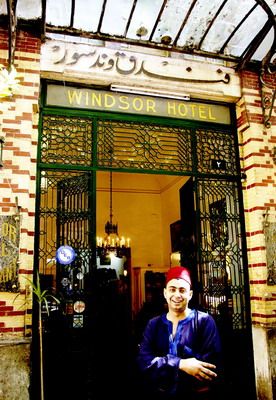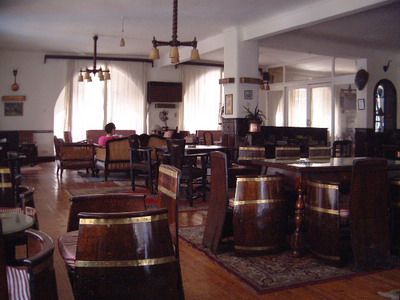Bergen Egypt Exploration Society
- Annual directory board meeting in Cairo, October 2010
It must be underlined from the outset that some members of our Society have been travelling regularly to Egypt since 1970. It is impossible to find places where they have not been. For others it has been an experience to visit places under their auspices, to learn from their insights and to see things trough their eyes. 40 years is a long time - even in Egypt!
WINDSOR HOTEL has been our home in Cairo for years. This time we met on October 11,. in order to continue our explorations and plan future adventures. The museum-like atmosphere of the hotel is a fitting setting for our meetings, its British military atmosphere being undisturbed by modern ideas of what a hotel should be like. The lounge with bar on the first floor is particularly picturesque, with its many memories from days gone by displayed in framed photos around all the walls. Already at the reception downstairs you can see pictures of famous people visiting Windsor. Some signs of damage done to the hotel in the popular uprising of 1952 are visible here and there, as for example in the breakfast-room on the 2. floor. Windsor narrowly escaped being set to fire as the old and legendary Shepheard's Hotel nearby went up in flames.
Windsor is a museum - not a modern hotel!
Aage Hauken (AH) had been spending some nights at the new Shepheard's, because of the unique Nile-view this hotel can offer its guests (so he says). After this he moved to Moewenpick Giza in order to live near the monuments (another excuse...?). He met with Knut Harald Ekle (KHE) and Jan Songstad (JS) at Windsor (actually, he stayed here after some weeks in Luxor, as he did last year, and insists that the place is super). From there we made excursions to some famous sites, the first of these was Old Cairo, KHE and JS being experts in Coptic.
OLD CAIRO is always worth a visit, due to its very old and interesting churches, its colorful bazaars and bookshops. This is "Cairo before Cairo", a living echo of the old settlement from Christian times, when this settlement was a military colony and the first city evolved around it. While on Coptic grounds, we had a rich opportunity to talk with young Christians of the Coptic faith, about Arabs and Islam, about Egypt, and about the discriminating laws that we hear about - and related topics. Above all we were looking for publications on the Coptic language, not at least editions of texts (a complete New Testament being our priority, or at least the four gospels).
But Arabic is the official language of the Copts today, and they have some distance to go in order to revive the old Egyptian language, at least for the use of the clergy. We have actually met priests who knew how to read it, and priests - including a bishop - who did not, or believed it to be Greek. Coptic is sung during the liturgy, but due to the noise of instruments it is really impossible to hear what is being sung. The tyranny of Arabic is as prominent today as it ever was. Actually, a Coptic bishop had recently said in public that Arabs should be regarded as visitors to Egypt, if not tourists, and therefore treated well. An uproar followed, not surprisingly, and Hosni Mubarak himself had to intervene to calm the row. But when visiting Old Cairo one can understand what the poor bishop intended with his words - here is a direct continuity back to the origins of Christianity in Egypt that makes the later development of religion in Egypt seem irrelevant.
The Hanging Church (Mu'allaqa) - built over parts of the old Roman fortress called Babylon - was naturally our first stop, but here the flow of tourists was so intense that the visit took some time. AH had ample opportunity to use the camera, and here was also an occasion for visiting old friends, one bookseller who immediately recognised us and where we found interesting material pertaining to the history of Christianity in Egypt. Other famous churches were duly visited: the sacred crypt of St. Sergius, Sta. Barbara, and the modern church of the Virgin. Mar Girgis (ST. George) and the wonderful new Coptic Museum will have to wait for next year (though we have been there on earlier visits).
This is a place one ought to return to regularly. We will come back next year.
DASHUR was the destination for our next expedition. Its attraction lies in the two pyramids on the site: the "bent" pyramid and the "red" one; in the horizon we see the "black" pyramid which unfortunately is closed to visitors at the moment.
Why the "bent" pyramid is bent is a topic of much discussion. AH had just bought a new book by Zahi Hawass on the pyramid builders (the early pharaohs) - called Mountains of the Pharaohs - and we discussed the various theories. Most likely the structure did show signs of collapsing, perhaps due to seismic changes in the plateau itself. By adding external fortifications - a kind of pyramid buttresses - the pyramid acquired the extraordinary shape we see today. Since we all have been inside this edifice before we did not enter, but walked around it taking photos and inspecting the structure. The remains of adjoining temples were also inspected. KHE had brought with him the necessary documentation for the entire complex.
The "red" pyramid - so-called because of the reddish colour of its stones - seems to be the third and final masterpiece of pharaoh Sneferu (the founder of the fourth dynasty), the structure he was working towards while experimenting elsewhere (as with the "bent" pyramid close by). Modern authorities argue that this was his final and highly successful attempt to build a pyramid, a structure that the fifth dynasty pharaohs would develop further. It is certainly a very beautiful structure, which goes for the interior as well (we had all been inside previously). Its steadiness is perfect, as are its proportions. After this architectural success the masterpieces at Giza came to be the next big achievement of the early pharaohs.
SAQQARA was visited in order to renew our impressions of some old and dear sights. Since the Serapeum was still closed (contrary to what was rumored in the press last spring) we concentrated on the pyramids of Ti and Teti, as well as the mastabas of Mereruka and Kagemni. There were obvious improvements to the access to Ti as compared to last year. Teti was so full of tourists that this visit took some time.
We had ample opportunity to practise our Old Egyptian by reading the many beautiful inscriptions on the outer and inner walls. The guards always show interest in tourists who can read the old language, and they frequently ask questions or try their own knowledge in comparison the ours. AH has an impertinent habit of correcting guides who make mistakes of grammar and vocabulary - even in front of their groups. But the way he does it - charmingly and wittingly - does preclude any unpleasant confrontations (in one case he patiently explained to a German-speaking guide - an Egyptian - the difference between neb as adjective and as substantive in the repetitive phrase all life strength and dominion). JS has an ingenious way of producing the right word or phrase whenever one of us gets lost in the old signs and symbols - and unlimited patience in explaining to the custodians. The same guards were quite liberal with allowing photography this afternoon, and AH made new efforts to record as much as possible. How much bakshish he lavished upon them remains a secret.
A special tribute was made to the Greek philosophers' monument. The sculptures are not in very good shape, but they have been given a nice modern setting among the sands, and photos commemorate this great moment.
A charming feature was the presence of the traditional Egyptian dog - Anubis alive! - as captured by AH's camera. One of them seemed to observe us closely, even to like us. Perhaps he thought we were destined for one of the tombs...
BOOKSHOPS is always one of the principal delights of Cairo. Old Cairo offers a good selection of modern titles, popular scholarly works as well as fiction (ancient Egypt has actually become the focus of many modern novelists, especially in the gengre of crime novels, with very varying success). But the more serious bookshops are to be found in the American University of Cairo and the old and established LEHNERT & LANDROCK down town. This last one is a gold mine for learned books on Ancient Egypt, and can offer a good selection of philological studies. The problem is always how to get them back home, since books tend to bring the weight of our luggage to the limit of what is allowed. AH has good experiences in sending books by post, and he warmly recommends this solution - ergo: go on buying books! At Lehnert & Landrock we had the good fortune of the proprietor having kept the English price labels, equating 1 British pound to one Egyptian - the case was a smaller and more handy edition from OUP of Gardiners immortal grammar!
WADI NATRUN was the natural focus for a Sunday visit. This time AH had to go there on his own, since this was his first visit on the spot: Monastery of al-Baramous (Deir Baramus) - Monastery of the Syrians (Deir al-Suryani) - Monastery of St. Bishoi (Deir Anba Bishoi) - Monastery of Macarius (Deir Abu Makar). Everywhere there were people flocking in and out, the morning liturgies having just taken place. There was no lack of visiting tourists. But all the buses filling the parking grounds outside the entrances were for the native Copts who came for the Sunday liturgies.
The old sites are wonderfully kept alive, very accommodating and with shops offering local religious art, the characteristic Coptic art that has followed this particular church through the centuries. Here and there are new buildings, even large churches, a sure sign that this branch of Christianity is still being fully alive.
Some of the churches are very old, as they can trace their origins back to the 4th century. For it was here that cenobitic life developed, the eremitical predecessors having lived further north at Kellia and Scetis. Here are churches everywhere, monuments of a history that still goes on and refuses to die. It is truly wonderful to see these places in function. And Sunday is the best day, not a weekday.
Most of all these places are small villages or mini-cities, protected by the old and massive walls that surround them - the Monastery of St. Catherine on Sinai is just a miniatyr version of those in the Wadi Natrun. Also many of the monks speak English and are very welcoming to visitors from abroad. The Coptic church is surprisingly international. In fact, the impetus to reintroduce and develop Coptic studies in schools and universities come from abroad. And presently it is made an effort in Egypt to make the old language come alive again, albeit in a tentative way.
On old Coptic grounds - such as in these monasteries - the modern development of Egypt as an Arab and Islamic country is easily forgotten. We find ourselves part of a Christian Egypt that gives direct continuity with the old past and guarantees its relevance for the present. At the same time we should be aware of the fact that Christians and Muslims are both children of Abraham and share the same faith in One Supreme Godhead.
Besides the excursions we had good opportunity to consider the future development of our society and of our homepage. This last one is an ambitious project, since the recording of our experiences in Egypt will take long time - hopefully it will not outlive us! AH is especially keen of sharing his rich photo gallery with others via the net. KHE and JS have many more translations of classical Egyptian literature to offer, and many memories of Egypt in years gone by. The installments on this homepage are therefore planned to come regularly as we develop this project. Deo volente!
Summing up: this year's directory meeting was an inspiring event. We agreed to meet again in Cairo for an extraordinary session next March.
1
2
3
4
5
6
OLD CAIRO 1
OLD CAIRO 2
OLD CAIRO 3
OLD CAIRO 4 - THE HANGING CHURCH
OLD CAIRO 5 - INSIDE THE HANGING CHURCH
OLD CAIRO 6 - SAINT GEORGE
SAQQARA 1 - JAN SONGSTAD
SAQQARA 2 - KNUT HARALD EKLE
SAQQARA 3 - AAGE HAUKEN
SAQQARA 4
SAQQARA 5
SAQQARA 6
SAQQARA 7 - ANUBIS ALIVE
SAQQARA 8 - THREE PHILOSOPHERS
WADI NATRUN 10
WADI NATRUN 11
WADI NATRUN 2
WADI NATRUN 3
WADI NATRUN 4
WADI NATRUN 5
WADI NATRUN 6
WADI NATRUN 7
WADI NATRUN 8
WADI NATRUN 9
WADI NATRUN MONASTERIES 1

WINDSOR HOTEL 3 - restaurant

WINDSOR HOTEL 1 - exterior

WINDSOR HOTEL 2 - entrance

WINDSOR HOTEL 4 -barrel_bar
 Contact / Kontakt
Contact / Kontakt